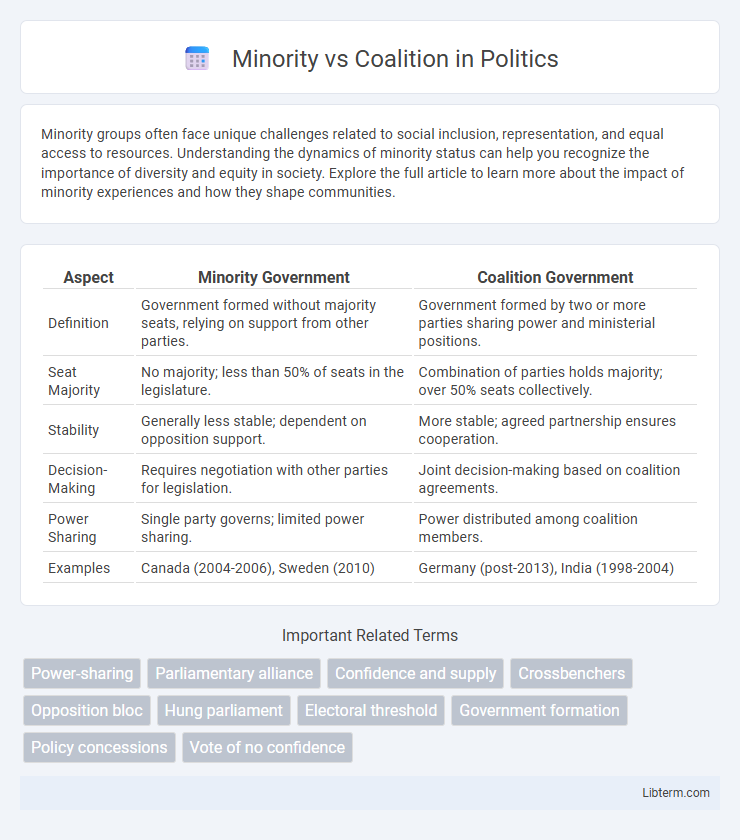Minority groups often face unique challenges related to social inclusion, representation, and equal access to resources. Understanding the dynamics of minority status can help you recognize the importance of diversity and equity in society. Explore the full article to learn more about the impact of minority experiences and how they shape communities.
Table of Comparison
| Aspect | Minority Government | Coalition Government |
|---|---|---|
| Definition | Government formed without majority seats, relying on support from other parties. | Government formed by two or more parties sharing power and ministerial positions. |
| Seat Majority | No majority; less than 50% of seats in the legislature. | Combination of parties holds majority; over 50% seats collectively. |
| Stability | Generally less stable; dependent on opposition support. | More stable; agreed partnership ensures cooperation. |
| Decision-Making | Requires negotiation with other parties for legislation. | Joint decision-making based on coalition agreements. |
| Power Sharing | Single party governs; limited power sharing. | Power distributed among coalition members. |
| Examples | Canada (2004-2006), Sweden (2010) | Germany (post-2013), India (1998-2004) |
Understanding Minority and Coalition Governments
Minority governments occur when the ruling party holds fewer seats than the opposition combined, requiring support from other parties to pass legislation. Coalition governments are formed through formal alliances between multiple parties to secure a majority and share executive responsibilities. Understanding these structures clarifies their legislative strategies and stability within parliamentary systems.
Key Differences Between Minority and Coalition
Minority governments hold fewer seats than the opposition, relying on external support to pass legislation, while coalition governments form through formal alliances between multiple parties with a shared majority. Minority administrations face greater instability due to uncertain support, whereas coalitions enjoy more stable governance through negotiated policy agreements. The key distinction lies in the formal partnership and shared executive power in coalitions versus the conditional, often informal arrangement characterizing minority rule.
Historical Context of Minority Governments
Minority governments have historically emerged in parliamentary systems when no single party secures an absolute majority, compelling them to rely on support from smaller parties or independent members to pass legislation. This phenomenon became particularly notable in European democracies during the 20th century, reflecting fragmented party landscapes and shifting voter allegiances. Understanding the historical context of minority governments highlights the challenges of political stability and policy-making in coalition-driven environments.
Formation Process of Coalitions
Coalition formation involves negotiation among multiple political parties or groups to establish a governing majority, often requiring compromise on policy goals and cabinet positions. This process includes assessing mutual interests, power dynamics, and voter mandates to create a stable alliance capable of legislative functioning. Unlike minority governments, coalitions share collective decision-making and distribute authority to maintain political cohesion and avoid frequent votes of no confidence.
Advantages of Minority Governments
Minority governments benefit from increased flexibility in policymaking, as they are not strictly bound by coalition agreements, allowing for quicker adaptation to changing political circumstances. This governance style often encourages greater negotiation and cooperation across parties, fostering more inclusive decision-making processes that can lead to more balanced legislation. Minority governments also hold the advantage of maintaining clearer accountability, as responsibility for policy outcomes is less diffused than in coalition arrangements.
Challenges Faced by Coalitions
Coalitions often struggle with conflicting interests among diverse party members, leading to difficulties in policy consensus and decision-making. Maintaining unity and effective communication can be challenging due to varying priorities and ideological differences, causing potential instability. Furthermore, coalitions face the constant risk of internal disagreements weakening their collective bargaining power and governance effectiveness.
Decision-Making in Minority vs Coalition
Decision-making in minority governments often faces challenges due to limited parliamentary support, requiring reliance on issue-by-issue negotiations and external backing to pass legislation. Coalition governments benefit from shared authority among multiple parties, facilitating more stable and collective decision-making processes through consensus-building and compromise. The dynamics in coalitions promote sustained policy development, whereas minorities must continuously secure alignment from outside parties to govern effectively.
Impact on Policy Implementation
Minority governments often face challenges in policy implementation due to a lack of majority support, leading to slower decision-making and frequent compromises. Coalition governments, while requiring negotiation among parties, tend to facilitate more stable and comprehensive policy implementation by pooling diverse political resources and achieving broader consensus. The increased collaboration in coalitions can enhance the legitimacy and durability of enacted policies compared to minority administrations.
Famous Examples Worldwide
The United Kingdom's Conservative minority government under Theresa May (2017-2019) relied on a confidence-and-supply agreement with the Democratic Unionist Party, highlighting challenges in parliamentary stability without a majority. In contrast, Germany's long-standing coalition governments, such as the CDU/CSU-SPD grand coalition (2013-2021), demonstrate the effectiveness of multi-party collaboration in maintaining stable governance. New Zealand's Labour-led coalition with New Zealand First (2017-2020) exemplifies how smaller parties can hold significant influence in policy-making within coalition arrangements.
Future Trends and Political Implications
Minority governments are projected to increase as electoral fragmentation persists, leading to more coalition negotiations with diverse party interests. Coalition dynamics will evolve with technology-enhanced negotiation tools, increasing transparency but complicating consensus-building among ideologically disparate partners. Political implications include greater policy instability and the rise of issue-based alliances, reshaping traditional party loyalty and governance strategies.
Minority Infographic

 libterm.com
libterm.com